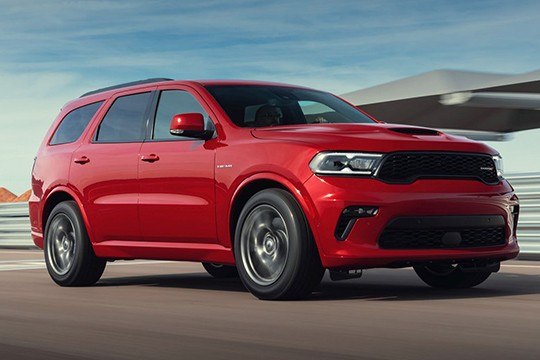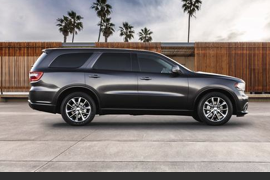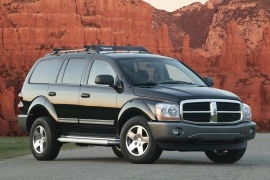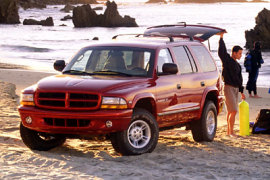DODGE Durango Models/Series Timeline, Specifications & Photos
First production year: 1997
Engines: Gasoline
Body style: SUV (Sports Utility Vehicle)
Dodge unveiled the first generation of the Durango at the 1997 North American International Motor Show. The car-maker unveiled the third generation in 2011 and updated it later on almost every year.
Maybe the 2021 model should have been completely new, but the car-maker didn't think it was the moment to launch it due to the world pandemic situation that led to financial difficulties for all the car-makers. Instead, they introduced a new facelift in July 2020.
The manufacturer revised the headlights from the outside, which now featured LED technology both for the lamps and for the daytime running lights. The grille was enhanced as well, and a new front bumper was installed. Apart from the SRT and the SRT Hellcat versions, which featured a different hood with air-scoops, the rest of the pack featured regular ones.
Inside, the manufacturer installed a new interior for the three-row SUV. A standard 8.4" U-Connect system was fitted as standard on the SXT and GT trim levels, while from the R/T and up models, a 10.1" touch-screen was fitted as standard.
Under the hood, Dodge installed two engine choices, apart from the SRT products. There was a 3.5-liter V6 unit offered in two power options and a 5.7-liter V8 Hemi that offered 360 hp. The standard transmission for the entire range was an 8-speed automatic. Dodge offered the Durango with either rear- or an all-wheel-drive system.
Dodge discontinued the second generation of the Durango in 2009, and customers were kept waiting until late 2010 when the American brand introduced the third generation of this model.
Those were some of the most challenging years for the American car industry due to the world financial crisis, and Chrysler was afraid to launch an expensive SUV. Still, it took the decision to make the step and introduced the third generation of the Durango in December 2010, with deliveries starting at the beginning of 2011. Two years later, in 2013, the automaker unveiled a refreshed version of the Durango at the 2013 New York Auto Show.
While the Durango’s second generation looked more like a bad boy, the third iteration of this nameplate came with a new, family-oriented approach. The front fascia boasted the brand’s specific cross-hair trim on the grille. In addition, the streamlined headlights were underlined by integrated LED daytime running lights, creating an upscale image for the car. Thanks to the unibody platform, the third generation of the Durango featured a lower greenhouse. Also noticeable on the side of the SUV were the enlarged rear fenders, which made the car look more muscular. For the upper trim levels, such as the R/T and SR/T, the automaker offered different aerodynamic packages with more aggressive-looking bumpers and grilles. Finally, at the back, the 2014 model year came with redesigned, single-line LED taillights.
Dodge made the third generation of the Durango with three rows of seats where up to seven adults could fit comfortably. While this was not new for a Dodge, the materials’ quality on the inside was significantly improved over the Durango’s second generation. A two-tone dashboard and better plastics for it were available, and the door cards were no longer made just with hard plastic areas. As expected, the lower grades came with fabric upholstery, but the upper ones provided luxurious leather-wrapped cabins. Fronting the driver was a new instrument TFT display for the instrument cluster. In addition, Dodge offered an infotainment unit with a color touchscreen and backup camera on the center stack. As expected, the front and second rows provided plenty of room for passengers, but even in the third row, there was enough legroom and headroom for adult-sized passengers. The trunk area was not impressive with all the seats up, but with the second and third rows folded, the Durango offered as much space as a minivan.
Dodge offered the Durango with either V6 or V8 engines, ranging between 290 HP (294 PS) and 360 HP (365 PS), paired with a new, eight-speed automatic transmission that drastically improved fuel efficiency over the model launched in 2010. Power went to the rear or in all corners, depending on the options.
The second generation of the Dodge Durango SUV was also the first to introduce the 5.7-liter Hemi engine in the lineup. It had five different trims, starting with the basic, 4x2, SE, which featured basic options such as central locking, air-conditioning and a six-disc CD player with MP3 capability.
The Durango was based on the same chassis as the Dodge Dakota pickup truck. It featured a three-row seating position and a seating capacity of up to seven passengers. Its off-road abilities were limited due to the heavy weight. On the transmission side it first came with an automatic 4-speed gearbox. Another 5-speed automatic and a CVT were added later on for different engine options.
In 2007, a facelift was introduced at the Dallas Auto Show, and a newly redesigned hood was shown to the public. New features included electronic stability control, a tire pressure-monitoring system, rear park assist, and a one-touch turn signal.
By the end of 2008, the demand for the big SUV decreased and in October the Newark assembly plant where the Durango was built was shut down. The world financial crisis hit the big SUV market the most. In its last production year, as a 2009 model, Dodge was promoting the first Durango Hybrid, where the big 5.7-liter V8 engine was helped by two electric motors with 65 kW.
Introduced as a 1998 model, the Durango replaced the older Ramcharger, which was on the production line since 1974.
The Durango shared the same platform with the Dakota pickup truck, and the carmaker didn't try to hide that by any means. Unlike the Ramcharger, the Durango was offered as a four-door full-size SUV that increased the market share of that brand.
Dodge designed the Durango in a retro-styling way, with the front fenders lower than the hood. The same recipe worked well for the Dakota. Its big, crosshair design on the grille and slim, horizontal headlights made the car look mean. Its flared fenders resembled the cars from the '50s, while the raked, curved windshield made the connection with modern vehicles.
Inside, Dodge installed the same dashboard design as the one fitted in the Dakota. For the 1998 model year, the carmaker offered an interesting option for a third, rear-faced, row of seats. With that option checked, the Durango offered room for up to eight people. The customers were not very thrilled by that and didn't ask for it. Later on, Dodge deleted that option from the list.
Chrysler decided to offer the same drivetrain as the one fitted in the Dakota, but later on, it added some more punch to the SUV. It included the 5.9-liter engine carried over from the Jeep Grand Cherokee Limited Edition and a supercharged V8 for the R/T version.



